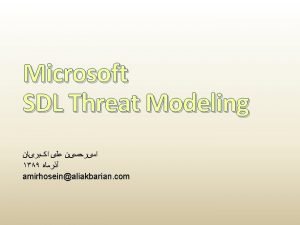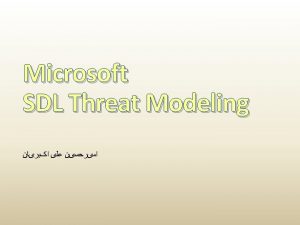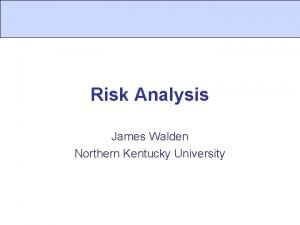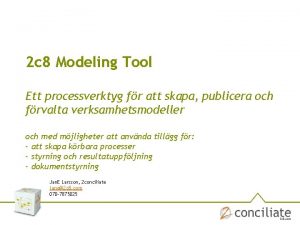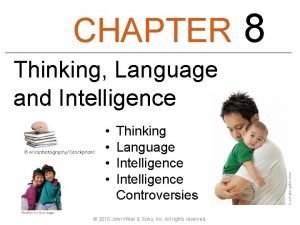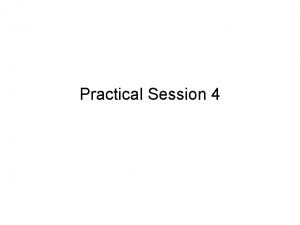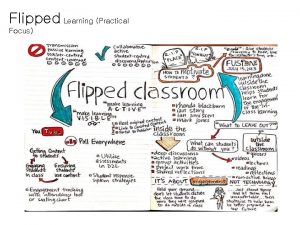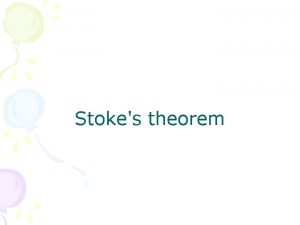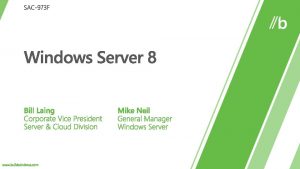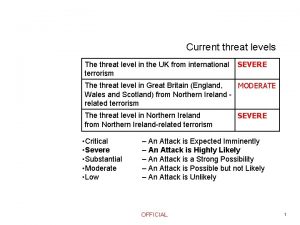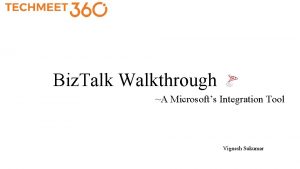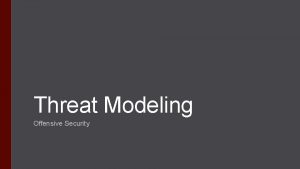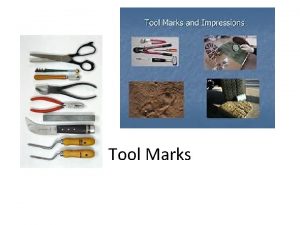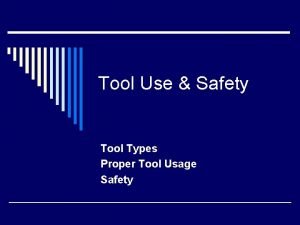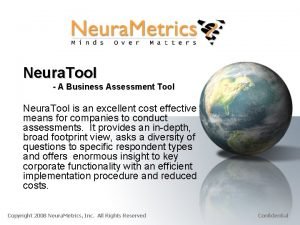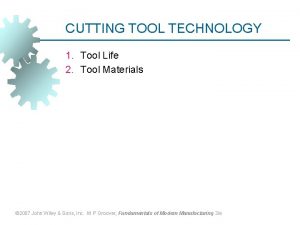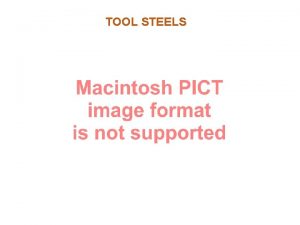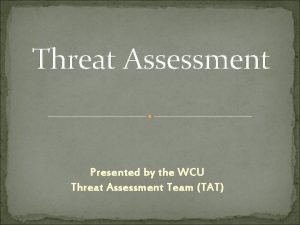Practical Threat Modeling with Microsofts Threat Modeling Tool





















- Slides: 21

Practical Threat Modeling with Microsofts Threat Modeling Tool 2016 Matthias Rohr

Agenda • Some Context on Threat Modeling • Demo • Conclusion 2

About Me • • Matthias Rohr Founder of Secodis Gmb. H Active in application security > 12 years Professional focuses: – Building secure web-based applications – Secure SDLC – Security test automation 3

MOTIVATION

Move Left to be More Secure! Specification Design Coding Testing Prod Advantages: 1. Relatively easy to fix / cost-effective 2. We can find a lot of (potential) security problems 3. Increases App. Sec maturity of organization 4. Vital for meeting architectural security requirements 5. …

What is Threat Modeling? 1 Threat modelling is a structured approach for identifiying potential security problems (threats) within the software specification or design. 2 A threat model is a model of threats, not just a list of threats.

What is Threat Modeling? Generic Risk Assessment Process Structure Analysis Generic Threat Assessment Process Threat Identification Methods System Decomposition Misuse / Abuse Cases Scoping Threat Assessment Threat Identification Determine Risks Questionaires / Threat Patterns Data Flow Analysis Threat Rating … Determine Mitigations Determine Countermeasures For each threat identification method, different techniques and tools exist!

Common „Threat Modeling Tools“ Threat Identification Technique Tool Abuse and Misuse Case § MS Visio* Questionnaires / Threat Patterns § MS Word* & MS Excel* Data Flow Analysis § MS Visio* * or similar products

Challenges • Repeatability / Consistency (=> threat model) • Ease of use (e. g. by non sec experts such as developers) • Mapping of custom environments / threat intelligence 9

(Some) Threat Modeling Tools Threat Identification Technique Tool Abuse and Misuse Case • Microsoft’s Elevation of Privilege (Eo. P) Card Game (Free) Questionnaires / Threat Patterns § Irius. Risk (Free + $) § Threat. Modeler ($) § MS Threat Modeling Tool (Free) Data Flow Analysis

DATA FLOW BASED THREAT MODELING WITH MS THREAT MODELING TOOL

Data Flow (Threat) Analysis - Elements External Entity Process Data Store • User • Browser • External Systems • Cloud • Web Application • Web Services • Assemblies • COM Objects • DLLs / EXEs • Database • File • Registry • Shared Memory • Queue / Stack Data Flow • Function call • Network traffic • RPC Trust Boundary • Internet Boundary • Local System / Processes Source: Michael Howard

The STRIDE Approach STRIDE is an acronym for these threat categories: • • • Spoofing Tampering Repudiation Information Disclosure Denial of Service Elevation of Privilege Malicious data manipulation Dispute of actions e. g. Stack Traces e. g. Application crash by malicious user input 13

Mapping STRIDE to Df. D Elements Element S T R I D E External Entity Process Data Store ? Data Flow Source: Michael Howard 14

Mapping STRIDE to OWASP TOP 10 OWASP Top Ten 2013 STRIDE A 1 - Injection Tampering, Spoofing A 2 – Broken Auth. & Session Management Elevation of Privileges, Spoofing, Information Disclosure A 3 – Cross-Site Scripting (XSS) Tampering, Spoofing A 4 – Insecure Object References Privilege Escalation, Information Disclosure A 5 - Security Misconfiguration Information Disclosure (and others) A 6 – Sensitive Data Exposure Information Disclosure A 7 – Missing Function Level Access Control Privilege Escalation, Information Disclosure A 8 - Cross Site Request Forgery (CSRF) Tampering, Spoofing, Elevation of Privileges A 9 - Using Components with Known Vuln. All A 10 – Unvalidated Redirects and Forwards Spoofing, Tampering 15

Microsoft Threat Modeling Tool 2016 § Free § Windows only § Version History - 2004, 2005: Threat Analysis & Modeling Tool (TAM) v 1, v 2: Windows GUI - 2011: SDL Threat Modeling Tool 3: Visio Plugin - … - 2014: Microsoft Threat Modeling Tool 2014: Windows GUI - 2015: Microsoft Threat Modeling Tool 2016: Windows GUI § Download: http: //aka. ms/tmt 2016 16

DEMO

DFD Threat Modeling Logic 1 A SOURCE has a type („Browser“) and attributes has a parent („Generic External Interactor“) with attributes 2 Sends data via a DATA FLOW with a type („HTTP“) and attributes 3 That may crosses a TRUST BOUNDARY with a type („Internet Boundary“) and attributes 4 To a TARGET has a type („Web. App“) and attributes has a parent („Generic Process“) with attributes Browser HTTP Internet Boundary Web. App 18

Simplified Template for Web Apps • Simplified Template for Web apps & examples available here: https: //github. com/matthiasrohr/OTMT • Some modifications I made: – – – – Removed stencils & properties note related to any threat logic Fixed some threat logic (e. g. XSS sanitization, Do. S logic) Added some useful stencils (e. g. security gateway) Added threat logic (e. g. No. SQL Injection, XXE) Added trust boundaries & network zones Added properties for countermeasures and risk … 19

Conclusion • Microsoft Threat Modeling Tool 2016 – Can be a great tool for technical threat modeling with strong customization capabilities that allows you to map your own environment & threats to it – With proper customized templates, usable for non-sec experts (e. g. architects) • Limitations: – – It is of course just a tool (requires processes, people using it, etc. ) System / Development centric approach (not suitable for everyone) Threats related to business logic etc. cannot be identified Combination with other approaches (e. g. questionairs) may really helpful 20

Thank you! Questions? Contact: m. rohr@secodis. com Demo Templates & Model: https: //github. com/matthiasrohr/OTMT
 Sdl model
Sdl model Misuse cases visio
Misuse cases visio Sdl threat modeling tool
Sdl threat modeling tool Sd3 security framework
Sd3 security framework Elevation of privilege game
Elevation of privilege game Threat modeling
Threat modeling Erickson nursing theory
Erickson nursing theory Dimensional modeling vs relational modeling
Dimensional modeling vs relational modeling Processverktyg
Processverktyg Potter's tool is data cleaning tool
Potter's tool is data cleaning tool Ideal op amp vs practical op amp
Ideal op amp vs practical op amp Dumpel.exe
Dumpel.exe Animal nutrition grade 11 practical
Animal nutrition grade 11 practical When you group subcategories within broader concepts
When you group subcategories within broader concepts Practical byzantine fault tolerance
Practical byzantine fault tolerance Jerry guo
Jerry guo Factor label definition
Factor label definition Practical clinical pathology
Practical clinical pathology Grade 4 natural science test term 3
Grade 4 natural science test term 3 Practical focus on learning
Practical focus on learning Cima professional experience requirements
Cima professional experience requirements George stokes
George stokes
